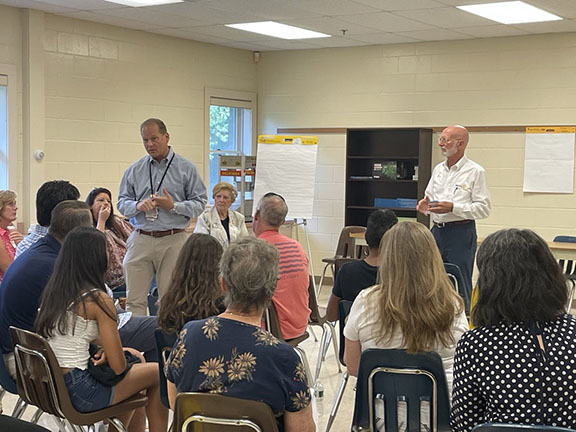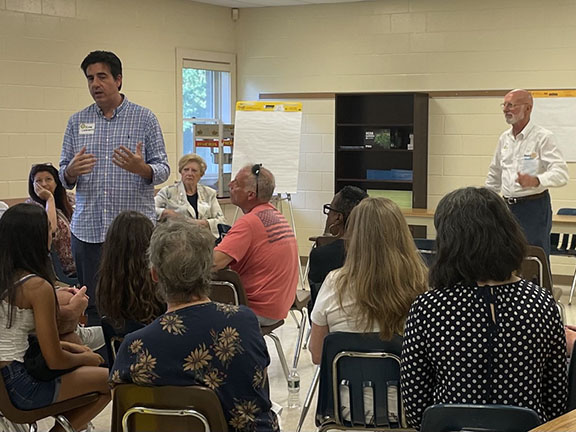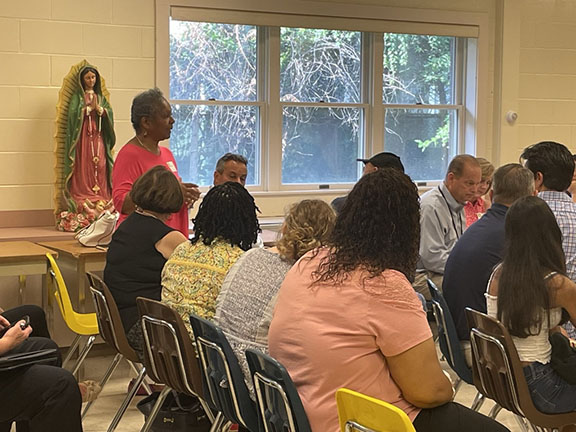
By Gloria Stravelli
RED BANK – More than 100 years into a partnership with the local business community, the Rotary Club of Red Bank is taking on a new role as a catalyst for social change.
Local Rotary officials facilitated a Community Needs Assessment Workshop earlier this summer, bringing together 35 stakeholders in the local community to identify current strengths and unmet needs, as well as models for collaboration among nonprofits.
The aim is to affect lasting change through addressing local issues that include a shortage of affordable housing and childcare options, according to Rotary officials, and encourage collaboration among the community groups.
“The concept of a Community Needs Assessment is fairly new and we’re doing it on a nationwide basis in Rotary,” explained Chuck Watson, past district governor of the Red Bank Rotary, during a recent interview. “We’ve done a handful already in New Jersey and we’re blessed the Red Bank Rotary has the staff who have the ability to execute and organize this to assess the needs of the community.”
To begin the process, the group held a round robin-style forum in late June at the parish center of St. Anthony Church so key community stakeholders could identify needs and ideas for future services. Participants included some 35 leaders of local nonprofits, clergy, business and political leaders and medical providers. Individuals from police and fire departments were invited but were not able to attend, Watson said.
Agencies and organizations participating in the 2022 Community Needs Assessment Workshop included: First Baptist Church of Red Bank; JBJ Soul Kitchen; YMCA of Greater Monmouth County; N.J. Department of Human Services; Lunch Break; Visiting Nurse Association of Central Jersey; HABCore; Salvation Army; Parker Family Clinic; T. Thomas Fortune Cultural Center; St. Anthony of Padua Parish, St. Crispin Society; Big Brothers and Big Sisters of Coastal and Northern NJ; Boys and Girls Clubs of Monmouth County; and the Monmouth Mental Health Association.

The focus of the workshop was to create a master list of unmet needs in the Red Bank community, Watson explained. The attendees listed the needs they see and hear about each day while providing outreach to the underserved.
“I challenged everybody who attended that meeting to tell me the top one or two or three needs they thought Red Bank has,” he said. “I left them wide open… and as we sat there and listed them, we came up with 31 of them. We found that most could be put into five categories. In no particular order they are: housing, transportation, childcare, behavioral health and easy access to health care.”
According to Watson, the plan is to create five focus groups, one for each of the categories.
“We’re going to invite subject matter experts and people from other communities who have addressed these same issues,” he said. “Most of these needs, as you know, are in communities after a long time, they’re not going to be resolved quickly and some of them will likely never be resolved totally,” he said.
“But we’re off to a great start. It’s our hope that these focus groups remain intact long-term.”
Each of the groups will work autonomously and the approach to each problem will be unique, according to the needs, as some may be only partially unmet.
“What’s the best way to address it? Is it right here in this room, or is it with money, or is it with a state agency? These are the people who have their boots on the ground,” Watson said.
The discussions were important to identify deficiencies as obvious needs are already being met and there is no reason to duplicate efforts.
“For example, no one said that hunger is on the top of the list. I’m going to say that’s because, thankfully, we have Lunch Break. And we have Soul Kitchen and we have St. Anthony’s pantry and we’ve got the Salvation Army pantry. Our community is blessed with agencies that look at food,” he said.
“Housing is an easy one because everyone who’s in housing knows there’s not enough,” he said. “So that group will have a different approach to solving that need. And there are some really creative people who will be in that group who think out-of-the box.”
The Rotarians shared a vision for how the groups working in tandem could encourage partnerships “by thinking out of the box,” Watson said. “You know, some needs are just unmet because all of the nonprofits stay in their own lane. There may be some lanes between two nonprofits and they might come to agree that one of them will take care of it or they’ll share it.”

Katie McAdoo, president of the Rotary Club of Red Bank, concurred. “I think when we break down any barriers, when we bring these groups of like-minded people together,” she said, “and they each have their own pitch for providing for the need and they see the success of when they collectively work together, I think really it will get things going and there’ll be a continuum. These groups will also provide an “organic sense of support” for stakeholders, she said.
Some of the agencies involved are small and all rely heavily on volunteers, McAdoo noted, so being able to reach out to another organization that shares the issues is important.
“There will be a natural synergy among these groups that we’re hoping will make them want to be together and tap into each other for the good and support of the community, but also that they find comfort with each other.”
Going forward, the Rotary Club’s role will be to support communication among the groups and keep everyone informed about progress, McAdoo said.
This article originally appeared in the September 8-14, 2022 print edition of The Two River Times.














